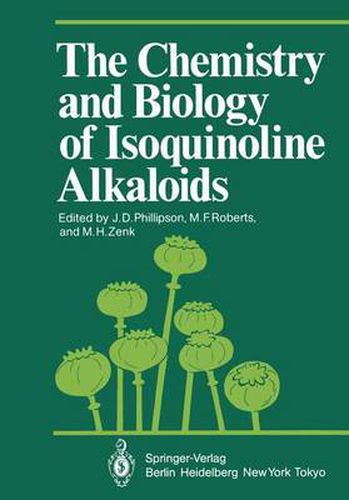Readings Newsletter
Become a Readings Member to make your shopping experience even easier.
Sign in or sign up for free!
You’re not far away from qualifying for FREE standard shipping within Australia
You’ve qualified for FREE standard shipping within Australia
The cart is loading…






This title is printed to order. This book may have been self-published. If so, we cannot guarantee the quality of the content. In the main most books will have gone through the editing process however some may not. We therefore suggest that you be aware of this before ordering this book. If in doubt check either the author or publisher’s details as we are unable to accept any returns unless they are faulty. Please contact us if you have any questions.
Isoquinolines form one of the largest groups of plant alkaloids and they in clude a number of valuable clinical agents such as codeine, morphine, eme tine and tubocurarine. Research into different aspects of isoquinolines con tinues in profusion, attracting the talents of botanists, chemists, bioche mists, analysts, pharmacists and pharmacologists. Many of these aspects are of an interdisciplinary nature, and in April 1984, The Phytochemical Society of Europe arranged a 3-day symposium on The Chemistry and Bi ology of Isoquinoline Alkaloids in order to provide a forum for scientists of differing disciplines who are united by a common interest in this one class of natural product. Each chapter in this volume is based on a lecture given at this symposium. Attempts have been made to make the aims and objectives, experimental findings and conclusions reached, intelligible to scientists of differing backgrounds. The introductory chapter, which is mainly based on a historical discus sion, stresses that plants containing isoquinolines have proved to be both a boon and a curse to mankind. The Opium Poppy, Papaver somniferum, produces the medicinally used alkaloids morphine, codeine, noscapine and papaverine whilst it also continues to provide drugs of abuse, particularly morphine and its readily prepared O,O-diacetyl derivative, heroin. Numer ous other alkaloids have been isolated from other members of the Papaver acea, and a knowledge of their presence and distribution within the various species has proved a useful adjunct to systematic botanical studies.
$9.00 standard shipping within Australia
FREE standard shipping within Australia for orders over $100.00
Express & International shipping calculated at checkout
This title is printed to order. This book may have been self-published. If so, we cannot guarantee the quality of the content. In the main most books will have gone through the editing process however some may not. We therefore suggest that you be aware of this before ordering this book. If in doubt check either the author or publisher’s details as we are unable to accept any returns unless they are faulty. Please contact us if you have any questions.
Isoquinolines form one of the largest groups of plant alkaloids and they in clude a number of valuable clinical agents such as codeine, morphine, eme tine and tubocurarine. Research into different aspects of isoquinolines con tinues in profusion, attracting the talents of botanists, chemists, bioche mists, analysts, pharmacists and pharmacologists. Many of these aspects are of an interdisciplinary nature, and in April 1984, The Phytochemical Society of Europe arranged a 3-day symposium on The Chemistry and Bi ology of Isoquinoline Alkaloids in order to provide a forum for scientists of differing disciplines who are united by a common interest in this one class of natural product. Each chapter in this volume is based on a lecture given at this symposium. Attempts have been made to make the aims and objectives, experimental findings and conclusions reached, intelligible to scientists of differing backgrounds. The introductory chapter, which is mainly based on a historical discus sion, stresses that plants containing isoquinolines have proved to be both a boon and a curse to mankind. The Opium Poppy, Papaver somniferum, produces the medicinally used alkaloids morphine, codeine, noscapine and papaverine whilst it also continues to provide drugs of abuse, particularly morphine and its readily prepared O,O-diacetyl derivative, heroin. Numer ous other alkaloids have been isolated from other members of the Papaver acea, and a knowledge of their presence and distribution within the various species has proved a useful adjunct to systematic botanical studies.